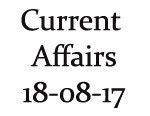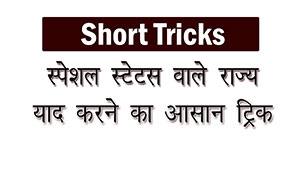-
Current Affairs 18th August 2017
Updated : 19-Aug-2017
Current Affairs 18th August 2017 - Important Points
- Completion of North Koel Reservoir Project approved by - Union Cabinet
- Missing links of dinosaur Chilesaurus discovered in - southern Chile, found
- New Metro Rail Policy approved by - Union Cabinet
- Vishal Sikka resigns as Infosys CEO, on - 18th August 2017
- Artificial womb to save extremely premature babies developed by - Scientists
- GEF Grant Agreement with World Bank signed by - Union Government
Current Affairs 18th August 2017 - Details
Completion of North Koel Reservoir Project approved by - Union Cabinet
The Union Cabinet chaired by Prime Minister Narendra Modi approved the proposal to complete the North Koel Reservoir Project in Jharkhand and Bihar on 16th August 2017 at an estimated expenditure of Rs 1622.27 crore to be incurred during three financial years. The Cabinet also approved storage of water in dam restricted at lower level to protect Palamau Tiger Reserve and Betla National Park.
Important Highlights- The project is situated on North Koel river which is a tributary of Sone river joining the river Ganga.
- This Reservoir is located in the most backward tribal areas of Palamau and Garhwa districts in Jharkhand.
- The construction of the project originally started in the year 1972 and continued till 1993 when Bihar's Forest Department stopped it.
- The Mandal dam will now be having storage capacity of 190 MCM with the new lowered elevation level (EL) of 341 meter.
Missing links of dinosaur Chilesaurus discovered in - southern Chile, found
Chilesaurus discovered in southern Chile, has reported to be the missing link that fills the huge gap between two of the major dinosaur groups- carnivores and herbivores.
This bizarre-looking dinosaur can be the answer to how one major dinosaur lineage had evolved into a completely new dinosaur group As per the researchers in the United Kingdom, the species have explained how mostly meat-eating, bipedal dinosaurs, evolved into the herbivorous, long-necked ornithischians. Journal by the name "Biology Letters" published this study.Important Highlights
Researchers from the Cambridge University and the Natural History Museum in the United Kingdom used a comprehensive dataset to analyse more than 450 anatomical
characteristics of early dinosaurs and rightly placed Chilesaurus in the dinosaur family tree.
The dinosaur effectively fills the huge gap between the two major dinosaur groups and shows how the division between them might have happened.
This dinosaur was first described in 2015. It lived during the late Jurassic period near about 150 million years ago.Missing links of dinosaur Chilesaurus discovered in - southern Chile, found
Chilesaurus discovered in southern Chile, has reported to be the missing link that fills the huge gap between two of the major dinosaur groups- carnivores and herbivores.
This bizarre-looking dinosaur is expected to be the answer to how one major dinosaur lineage might have evolved into a completely new dinosaur group As per the researchers in the United Kingdom, the species have explained how mostly meat-eating, bipedal dinosaurs, evolved into the herbivorous, long-necked ornithischians. Journal by the name "Biology Letters" published this study.Important Highlights
- Researchers from the Cambridge University and the Natural History Museum in the United Kingdom used a comprehensive dataset to analyse more than 450 anatomical characteristics of early dinosaurs and rightly placed Chilesaurus in the dinosaur family tree.
- The dinosaur effectively fills the huge gap between the two major dinosaur groups and shows how the division between them might have happened.
- This dinosaur was first described in 2015. It lived during the late Jurassic period near about 150 million years ago.
New Metro Rail Policy approved by - Union Cabinet
The Union Cabinet has approved new Metro Rail Policy focused on cost reduction, compact urban development and multi-modal integration on 16th August 2017. This new Metro Rail Policy is expected to enable the growing metro rail targets realization to a large number of cities.
Important Highlights
- The policy has enabled private investments across a range of metro operations making Public-Private Partnership (PPP) component mandatory to avail central assistance for new metro projects.
- It is seeking to ensure a catchment area of 5 kms on either side of metro stations in order to provide necessary last mile connectivity via feeder services, Non-Motorised Transport infrastructure like cycling pathways, walking pathways and introduction of para-transport facilities.
- It mandates evaluation of various modes of mass transit like Bus Rapid Transit System (BRTS), Tramways, Light Rail Transit, Metro Rail and Regional Rail in terms of demand, capacity, cost and ease of implementation to ensure that least cost mass transit mode is selected for public transport.
- It also mandates setting up of UMTA (Urban Metropolitan Transport Authority) to prepare Comprehensive Mobility Plans for cities to ensure complete multi-modal integration.
- It specifies a shift from the present ‘Financial Internal Rate of Return of 8 percent’ to ‘Economic Internal Rate of Return of 14 percent’ to approve metro projects.
- Transit Oriented Development (TOD) has been mandated by it to promote compact and dense urban development along metro corridors as TOD reduces travel distances besides enabling efficient land use in urban areas.
- Just to ensure financial viability of metro projects, the Policy also needs the states to clearly indicate the measures to be taken for commercial development at stations and for other means of maximum non-fare revenue generation through advertisements, lease of space etc.
- It empowers States to make rules and regulations and set up permanent Fare Fixation Authority in order to revise fares timely.
- States are also empowered to take up metro projects and exercise any of the three options just to avail central assistance - Grant given by Union Government, PPP with central assistance under the Viability Gap Funding scheme, and 50:50 Equity sharing model between state governments and Union Government.
- The policy mandates private sector participation in metro services in different ways such as Cost plus fee contract, Gross Cost Contract and Gross Cost Contract.
Vishal Sikka resigns as Infosys CEO, on - 18th August 2017
Vishal Sikka resigned as Managing Director and CEO of Infosys on 18th August 2017. The board has accepted his resignation with an immediate effect. Sikka will be remaining with Infosys as executive vice-chairman, as stated by Infosys in a notice to stock exchanges. It is a newly created position at Infosys. Infosys has appointed new chief operating officer UB Pravin Rao as an interim managing director and CEO.
More about Vishal Sikka- Indian-American Vishal Sikka took over as the first non-founder Chief Executive of Infosys in June 2014.
- Vishal Sikka was a member of the Executive Board and the Global Managing Board of SAP AG, leading all SAP innovation and products globally before servicing Infosys.
- He is the creator of the concept of timeless software which represents the products renewal without disrupting the customer environments.
- He was ranked as 32nd most powerful people of the year in 2017 by India Today magazine in its India's 50 most powerful people of 2017 list.
Artificial womb to save extremely premature babies developed by - Scientists
Scientists have recently developed an artificial womb that has been successfully tested to incubate healthy baby lambs for a week. This advanced technology is expected to save the lives of extremely premature human babies in future. The Researchers from the Western Australia University and Tohoku University Hospital in Japan.
The main aim of the researchers is to develop an effective treatment strategy for an extremely premature infants born at the border of viability which is around 22-23 weeks.‘The American Journal of Obstetrics and Gynecology’ has published this study.
Important Information
- The preterm lambs were kept in an infection-free condition, healthy for a period of one week successfully.
- This therapy used to incubate the lamb babies is called EVE (ex- vivo uterine environment) therapy.
- These lambs have showed good growth in the period when they were kept inside the artificial womb.
- The equipment has high-tech amniotic fluid bath combined with an artificial placenta.
- EVE therapy could be used to prevent the severe morbidity suffered by extremely premature infants with further advancement.
- "The end goal of creating this artificial womb is to provide preterm babies the chance to better development of their lungs and other important organs before coming to the world," he added.
GEF Grant Agreement with World Bank signed by - Union Government
The Union Government signed a Grant Agreement worth USD 24.64 million from the Global Environment Facility (GEF) of the World Bank for Ecosystem Service Improvement Project on 16th August 2017.
Joint Secretary (MI), Department of Economic Affairs (DEA), Ministry of Finance, Sameer Kumar Khare signed the agreement on behalf of the Indian government and Hisham Abdo Kahin who is the Acting Country Director for India on behalf of the World Bank.
The World Bank has financed the project entirely out of its GEF Trust Fund with the total duration of five years.The Ministry of Environment, Forest and Climate Change (MoEF&CC) would be implementing this project in the Chhattisgarh and Madhya Pradesh states through Indian Council of Forestry Research & Education under the National Mission for Green India.














